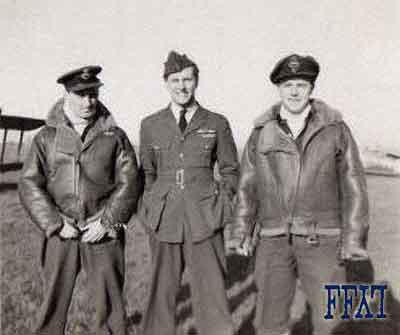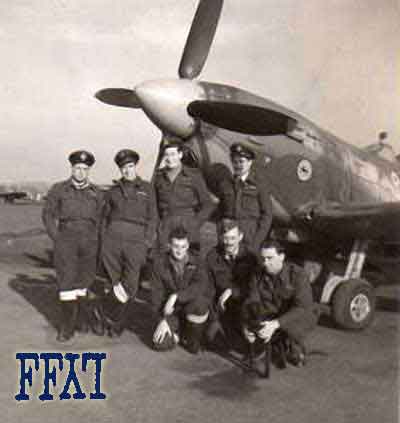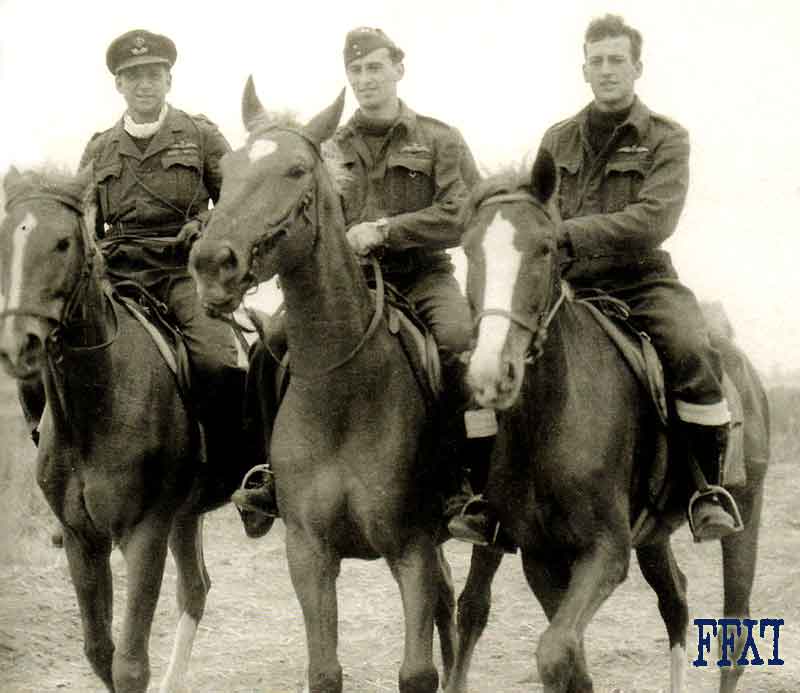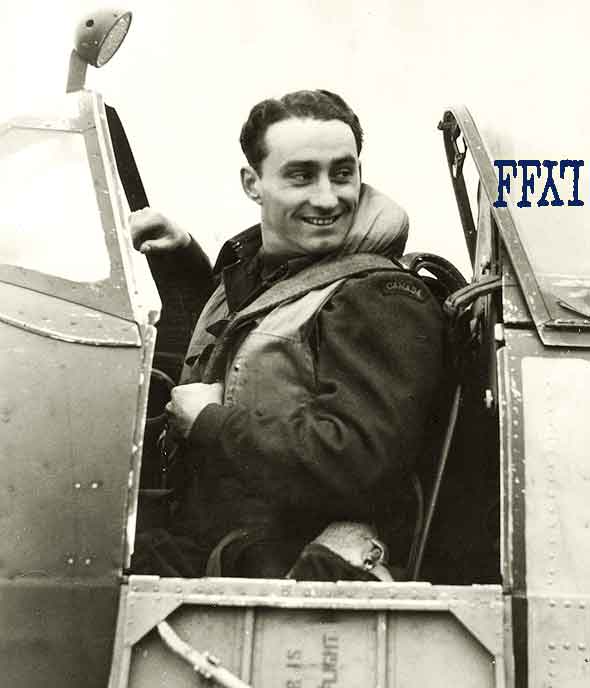|
--------------------------------------------------
Quoted from an email from Pierre's son Peter :
"During the war, my father flew under an alias, Pete Logan. Why? During WW2, my father's mother and siblings lived in Bonneville, France, and my father's superiors felt that his family could face retaliation should the Germans ever learn of my father's French roots.
My father did have some claims; however, his records are incomplete. When he went from being Pierre Lecoq (R77174) to Peter Logan, the official records for Pierre Lecoq were totally erased or lost ... What I do know, is that after my father's tour of duty ended in July of 1944, in lieu of returning to England for a rest, he donned civilian clothing and headed east to join his immediate family in Bonneville, FRANCE. Being perfectly bilingual, my father had no problem communicating in French. In order to reach his family, he had to travel through enemy occupied territory; hence, along the way he assisted the French Resistance movement in defying the Germans, and also assisted downed Allied pilots in their quest to escape enemy territory. I don't know exactly when my father returned to Canada, but he was in the reserves (City of Montreal 438 Squadron) after the war while attending McGill University (Medicine Class of 1952)."
--------------------------------------------------
He joined the RAF pre-war &
Flew in the Battle of Britain
Later transferred to the RCAF
He ended the war as a F/L
Became a medic
He died in 1970 |
--------------------------------------------------

Lecoq, George Beurling and John Hodgson
Back Row: Dave Goldberg, Jerry Preston, Mac McGarrigle & Bill Myers. Front Row: Doug Lindsay, Chuck Thornton & Pierre Lecoq w/ dog |
 |
--------------------------------------------------
Use Wolf Squadron Spitfires As Dive Bombers in France
London, Monday, April 9, 1944 - (CP) - Canada's Wolf Squadron used its Spitfires in a new role — as fighter-bombers — Saturday, when bombs were dropped on a military target in Northern France. Airmen said the only opposition was negligible flak, and all but one bomb landed in the target area.
"It was all over in three minutes," said F/O James Preston, St. Catharines. "Then we circled a couple of times and came home in formations, leaving a column of black smoke rising 1,000 feet.
We peeled down one after the other in a 5,000-foot dive, and each let his bombs go as he reached the bottom. I could see mine land one after the other as they exploded right in the target area."
Other Wolf Squadron members participating included F/Ls J. D. Lindsay, Arnprior; J. P. Lecoq, Montreal; John Hodgson, Calgary; F/O J. D. Orr, Vancouver; P/O W. J. Myers, Windsor.
Other Spitfires flew offensive patrols over France.
--------------------------------------------------

Andy Mackenzie, Pierre Lecoq & Doug Lindsay
--------------------------------------------------
R.C.A.F. MEN RIP TRAINS, TROOPS ACROSS EUROPE
With A Canadian Fighter Wing in Britain, May 21, 1944 - (CP) - The R.A.F. 2nd Tactical Air Fore, with a Canadian Spitfire group under Wing Cmdr. Lloyd V. Chadburn of Aurora playing a prominent part, ranged across the Netherlands, Belgium and France today in a great softening-up of the enemy's rail transport which might have to bear the brunt of troop-carrying traffic when the invasion begins.
Swift fighters and fighter bombers of the Tactical Air Force and Air Defence of Great Britain, Joined forces for their biggest operation of the war against the Nazis' overloaded and battered transport machine in Western Europe. Complete results of the operation are not yet compiled, but with bombs, cannon and machine guns, the British and Canadian fliers attacked this minimum list of targets with excellent results:
Thirty-five military supply trains, 13 locomotives (five of which were seen to blow up), a large number of military lorries, staff cars, tugs, barges, flak towers and other military installations.
Got Two Jerries
F/L J.B. Kerr of Toronto, member of the City of Edmonton Mosquito Squadron, destroyed an enemy bomber and shared in the destruction at a second with an American Mustang pilot during a sweep over the Low Countries.
Kerr downed the bomber of the French Leo 45 twin-engined type near Aalborg in Northern Denmark. The Canadian pilot, flying with an English navigator, fought off attacks by a FW-190 and a Messerschmitt 109 after shooting down the enemy plane.
The Canadians also struck in the area northwest of Paris, accounting for 18 trains as well as an assorted bag of lorries, army buses, staff cars dispatch riders and other enemy personnel.
The airmen flew through vicious anti-aircraft fire thrown up by flak cars which the German Command has attached to many trains moving through Europe in a futile effort to husband its dwindling rolling stock.
Besides the far reaching strike against the railroads, 2nd Tactical Air Force planes flew escort missions for light bombers and offensive patrols, damaging 12 barges on one thrust to the Brussels area.
Airfield Plastered
Again the Luftwaffe let the challenge in its skies go unheeded. The only enemy aircraft seen were on an airfield near Bloches and this was plastered with shellfire.
Twenty planes were lost, some of them Canadian, but the pilot of one fighter is known to be safe.
Chadburn did not go up himself but his old City of Oshawa Squadron, led by S/L Freddie Green, DFC, Toronto, was in the forefront of the Canadian attack. Pilots of the squadron attacked 13 trains, six of which were shared by F/L Don Hayworth of Regina and F/O R. Sharun of Toronto.
"The most amazing thing about it all," Green said, "was that you could fly about France and not see any enemy aircraft."
Three trains were damaged by F/Os A.G. Borland of Guelph and A.R. McFadden, Springdale, Alta. and four others were shared by F/L R.D. Forbes-Roberts, Vancouver; D.R. Cuthbertson, Brantford, and W/O Ron McRae, Spencerville.
Shot Up Four Trains
The Red Indian Squadron under S/L W.A. Conrad, DFC, Richmond, Ont., shot up four trains. F/O R. Cook of Clinton and P/O Bill Warfield of New York City teamed in a Joint attack on one train. Warfield went for the flak car in the centre of the train and then fired his guns at another in the rear, while Cook stopped the engine with a couple of well-placed bursts of cannon fire.
Another train was attacked by F/L Paul Johnson of San Diego, Cal., who also shared in damaging another two with F/L Johnny Drope of Regina and F/O Gordon Smith of Vancouver and Nelson. Johnson's Spitfire was hit by flak but he returned safely
Personnel Also Attacked
A standing train was attacked outside a station by a pair of Wolf Squadron pilots, F/L John Gordon of Edmonton and F/O Harry Boyle of Saskatoon. The engine was left with clouds of steam pouring from it.
Johnston and F/L C.T. Brown of Prescott attacked two truckloads of soldiers, and F/L Peter Logan of Montreal blasted a German staff car.
"An officer Jumped out and lay flat on the ground," said Logan. "I could see my bullets spattering around and through him."
F/L Andy MacKenzie, DFC, of Montreal, who has just been appointed a flight commander in the Wolf Squadron, afterwards set the staff car on fire.
--------------------------------------------------
Victories Include :
| 23 June 1944 |
one FW190
one FW190 |
destroyed &
damaged |
1 / 0 / 1
--------------------------------------------------
|






